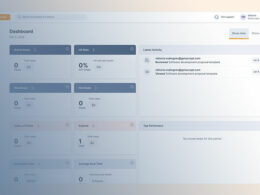Top 5 UI/UX Design Trends for 2024

The user interface (UI) is the graphical representation of your software. If you are building an app, that would be the visual design, placement of different app components, and navigation options. However, you can’t focus solely on UI because user experience (UX) is an equally important part of the app development process. UX considers all interactions that a user has with your app and the effect those actions have on them.
The UI/UX impact on app solutions is immense. Our guide can help you understand how to create an immersive digital experience for users of your app. Check out the best UI/UX design trends to apply in 2024 and beyond.
1. Scrolling Animation
Scroll animation is a particular action that users trigger by scrolling a webpage. The idea is to improve interface dynamics and user engagement. Website creators use scrolling animations to highlight specific products, present important data, or point out critical parts of a webpage. At the same time, it’s important not to overwhelm users. Another vital component is to ensure your animations work on different devices and app versions.
Some popular techniques for using scrolling animations include:
- Fade-in animations. As a user scrolls, a fade-in appears. That could be a picture, text, or any element the developer finds suitable.
- Parallax scrolling. The technique includes a background that moves slower than the foreground while a user is scrolling. The idea is to make the browsing experience more fun while featuring a product or a call to action.
- Sticky elements. The basic idea is to stick another element of the page on the basic one. You do this with the purpose of displaying related or particularly important content the user will not be able to scroll down.
2. Virtual Try-On
Source: Pixabay
The next UI/UX trend is particularly helpful for online shopping places, especially those that sell clothing and accessories like jewellery. The technique includes leveraging AI and other high-tech capabilities to allow a user to try the desired item virtually before purchasing it.
Here are the benefits of a virtual try-on:
- Improving engagement. The feature is appealing to most users and should improve engagement by default. Your business will gain a competitive advantage since not many shopping places offer this feature nowadays.
- Reducing returns. According to Shopify, e-commerce return rates go up to 30%. Inaccurate sizing is among the main factors, and virtual try-ons are a way to address this problem. It can also help reduce customer dissatisfaction by helping remove uncertainty regarding purchasing a product, especially clothing and accessories.
- Enhancing personalisation. Customers could receive product recommendations, which increase online shopping personalisation. These personalised features help strengthen the bond with the brand, which could boost business profit.
3. Leveraging Data-Driven Personalisation
If you want to create an optimal user experience, it’s important to consider your target audience. You don’t use the same trends for all users. Factors like demographics, preferences, and behaviour patterns can help optimise user journeys. That’s why leveraging user data is vital to making the right design decisions.
An important thing to consider is ethical concerns. Users should be informed regarding the data your site collects. It’s vital to maintain transparency and follow any data privacy regulations. That’s why most websites post notifications and obtain customer consent regarding data collection.
Some unique techniques to optimise user experience are the following:
- Predictive modelling. The idea is to analyse current and historical data to predict potential buying habits or user behaviour in the future.
- A/B testing. You can create two versions of your app or website and test them to collect data regarding user experience. Once you have sufficient information to see which version is more successful, it becomes the definitive version to use in the foreseeable future.
- Contextual awareness. It’s a technique where the app or website reacts based on the person who uses it. For example, the app could receive the user’s location and display the localised version. Other examples include offering day or night mode based on the time of the day or different features depending on the device type.
Large companies like Netflix and Amazon are great examples of leveraging data-driven design. For example, Netflix collects opinions about the TV shows users watch to offer the best possible suggestions for the next content to watch.
4. Automating User Testing With AI
Artificial intelligence is changing many aspects of our lives, and that includes the process of app development. You can leverage AI to create automated user testing. Tools can help automate particular tasks, including the following:
- Usability testing. Even if only some aspects are possible to automate, AI can provide significant help in analysing user behaviour.
- A/B testing. AI can help analyse data to see which version of the two tested works better for the users.
- User feedback analysis. You can use AI to prepare surveys and analyse feedback to receive valuable recommendations.
Time and cost savings are the obvious benefits of automated user testing. Instead of analysing the data yourself, AI does the job for you and ensures employees can spend time on other tasks.
5. Multi-Modal Interaction
Top-quality software solutions must consider offering users multiple options to interact with the app or website. Using a mouse on a PC or touchscreen on your mobile devices, along with image recognition, motion sensors, and voice commands, are some of the options.
Here are the top benefits of multi-modal interaction:
- Increasing accessibility. Some users might only interact with your website in a single specific way, so offering multiple communication methods can enhance accessibility.
- Improving user engagement. Multi-modal interaction provides a more immersive user experience.
- Boosting the efficiency of tasks. Some ways to do this include helping reduce errors and improving flexibility in completing a particular task.
Statistics indicate that over a billion voice searches occur every month. Implementing this and other interaction options improves user experience by adding intuitiveness to “communicating” with your app or website.
Conclusion
Innovations are crucial for app development, especially in user interface and experience. Following the latest trends improves overall UI and UX, ensuring you boost user engagement and provide a better experience overall. That leads to improving brand awareness, strengthening the relationship with potential and regular users, and all that should result in increasing profit and ensuring software success. The trends mentioned in this guide could help optimise UI and UX, so don’t hesitate to incorporate them into your current projects.
- Face to Face: Video Calling Apps Like Facetime - May 14, 2024
- What is JavaScript? An Introduction to Web Programming - May 14, 2024
- Mastering Elixir for Long-Term Product Evolution - May 14, 2024








